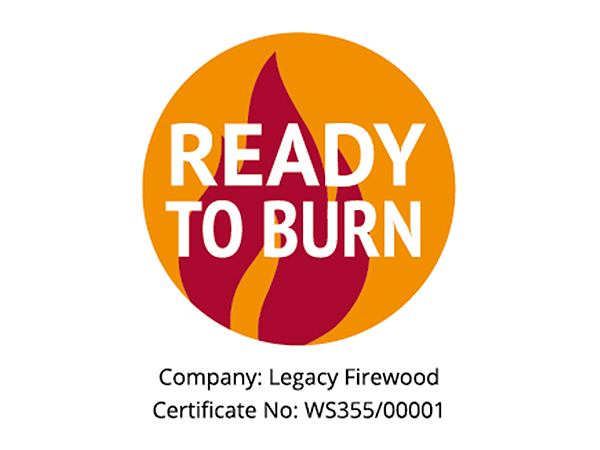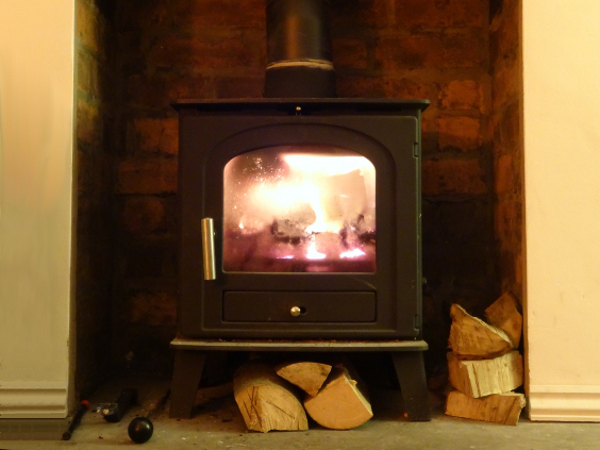Burning Wood on a Wood Burning Stove
The single most important piece of advice on burning wood on a wood burning stove is to ensure that the wood is well seasoned, with a moisture content of below 30%. Burning wood that is not properly seasoned, not only provides an inefficient fuel source for your burner, but also produces resinous fumes that will soon build up deposits in your flue. This can present a flue fire risk and lead to reduced efficiency of your flue.
For information about different types of wood to burn, click here.
A lot of people keep their store of seasoned logs outside, in a purpose built wood store. This is fine and enables quite a large quantity of wood to be stored. However, a common mistake is bringing a dry but cold log in from outside, chucking it straight on the stove and then wondering why the stove has died down. A log brought in from the cold will take a long time to reach a combustible temperature, absorbing a lot of the accumulated heat within the firebox of the stove. The stove will then take some time to get back up to temperature. It is best to bring an evenings supply of logs in from the cold, keep these by the stove to warm up and then feed the fire from these.
Another common mistake is feeding the fire too often, or keeping the door open for too long when feeding the fire. Every time the door of the stove is opened, accumulated heat is lost from the firebox that has to be built up again to get the stove up to its proper and most efficient running temperature. Try to minimise the amount of times that the stove door is opened. Refuel the fire and let the logs burn right down to hot embers before refuelling.
When refuelling your stove, avoid the temptation to pack it full of logs, one or two logs should be sufficient and allows for plenty of air movement within the firebox.
Additional Notes
Try to avoid burning too much paper on your stove, this produces a lot of ash and ends up clogging up the fire.
Avoid burning man made wood materials such as ply wood and particle boards, the adhesives used in these materials can produce poisonous fumes, and can also lead to a build up of deposits in your flue. Painted timber should also be avoided for the same reasons.
If you have a multi-fuel stove, burning a mixture of wooden logs and smokeless fuel briquettes can produce some very good results. The wood produces a nice flame whilst the briquettes help to keep heat in the base of the fire, and burn for a very long time. One point to note is that if burning smokeless fuel, the resulting ash is not good for composting, pure wood ash can be added to your compost bin or heap.
Using the air control valves on your stove
Every stove has its own burning characteristics and you will need to experiment and spend some time getting to know what works best with your stove. Even the same make and model of stove in different houses can act differently. The flue or chimney, or even the surrounding geography can have an effect on how airflows through a flue and affect the performance of a stove.
Most wood burning stoves and multi-fuel stoves have a bottom air vent and a top air vent. Wood burns best with a good bed of ash laid down in the bottom of the stove and an air supply from the top.
When lighting your stove, open both air vents fully. On initially lighting, it can be an advantage to crack the door open slightly to provide additional air flow through the firebox. Once the fire is established, close the door and then close down the bottom air vent gradually. If the fire dies right down at this point, open the bottom vent slightly for a bit longer until the fire is better established.
Once the fuel in the stove is burning properly, the temperature of the stove can be controlled using the top air vent. This can be quite an art to get this setting right. If the top vent is open fully, the fire may look good and as if it is burning fiercely, however, you will get through a lot of wood fuel and a lot of the heat will disappear up the flue. The idea is to throttle the top vent down until the wood is burning with a nice steady flame without dying down or burning fiercely. This reduces the flue temperature and gets the firebox as hot as possible, which then radiates heat into your room. Some wood burning aficionados will fit a magnetic flue thermometer so that they can monitor the flue temperature. The flue temperature needs to be hot enough to carry the fumes up the flue but being too hot is a sign that you are losing heat.



